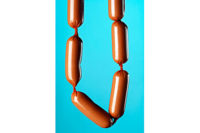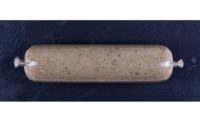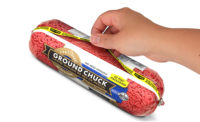
The chub is proving to be one of the meat sector’s most resilient offerings.
Decades after its emergence, product revenues are steady and selections are increasing. Sales of ground beef chubs in the 70 to 77 percent lean category (which accounts for 93 percent of ground beef chub revenues) were up 1.9 percent for the 52 weeks ending July 25, 2010, reports FreshLook Marketing Group, a Hoffman Estates, Ill.-based research firm.
New varieties of chubs also are being released. Butterball LLC, Garner, N.C., this summer rolled out three types of fresh ground turkey in one-pound chubs: All-Natural 93-percent lean and 85-percent lean products and 91-percent lean Seasoned turkey.
Kari Lindall, Butterball director of marketing, says the items are designed for convenience, noting that packages are easy to open and are compact for efficient storage in refrigerators and freezers.
Shelley Bradway, marketing manager for the Centennial, Colo.-based National Cattlemen’s Beef Association (NCBA), says the audience for chubs is primarily consumers looking for value.
“Chubs make it easy for shoppers to buy in bulk and store or divide it up for later use,” she adds. Retailers also can offer case-ready chubs for a lower price than freshly trimmed products because of the reduced labor, she states.
Chubs initially consisted of 10 and 12 pounds of meat that were delivered to retail locations for back-room grinding. The proteins then were packaged in PVC trays or overwrap materials and placed on shelves.
Products in the early 1990s evolved into smaller five-pound case-ready portions with graphics and recipes printed on the film. Many operators today also are merchandising the proteins in one- and three-pound packages with varying leanness levels.
Among the chubs’ key attributes are an oxygen-free barrier package with an 18- to 21-day shelf life (compared to about 10 to 14 days for proteins in modified atmosphere packaging); film that can be printed with marketing messages; and a package that can easily be frozen without the risk of sustaining freezer burn.
Recent improvements include packages with tighter fits that also are designed to retain their shape for greater merchandising appeal.
Enhanced graphics—the result of print being trapped within the film layers—also is resulting in higher gloss and a more attractive shelf presentation.
In addition, chubs can be tailored to support varying merchandising initiatives. Suppliers, for instance, can produce two-pound products if requested and affix specific designs or promotional data on the film.
Indeed, chub manufacturing costs often vary in accordance with the types of graphics on packages. High-gloss film, for instance, typically raises the price by a few percentage points.
While the colored film covering the entire package helps maintain freshness and product quality longer, it also prevents shoppers from viewing the meat before purchasing—a negative for many consumers.





